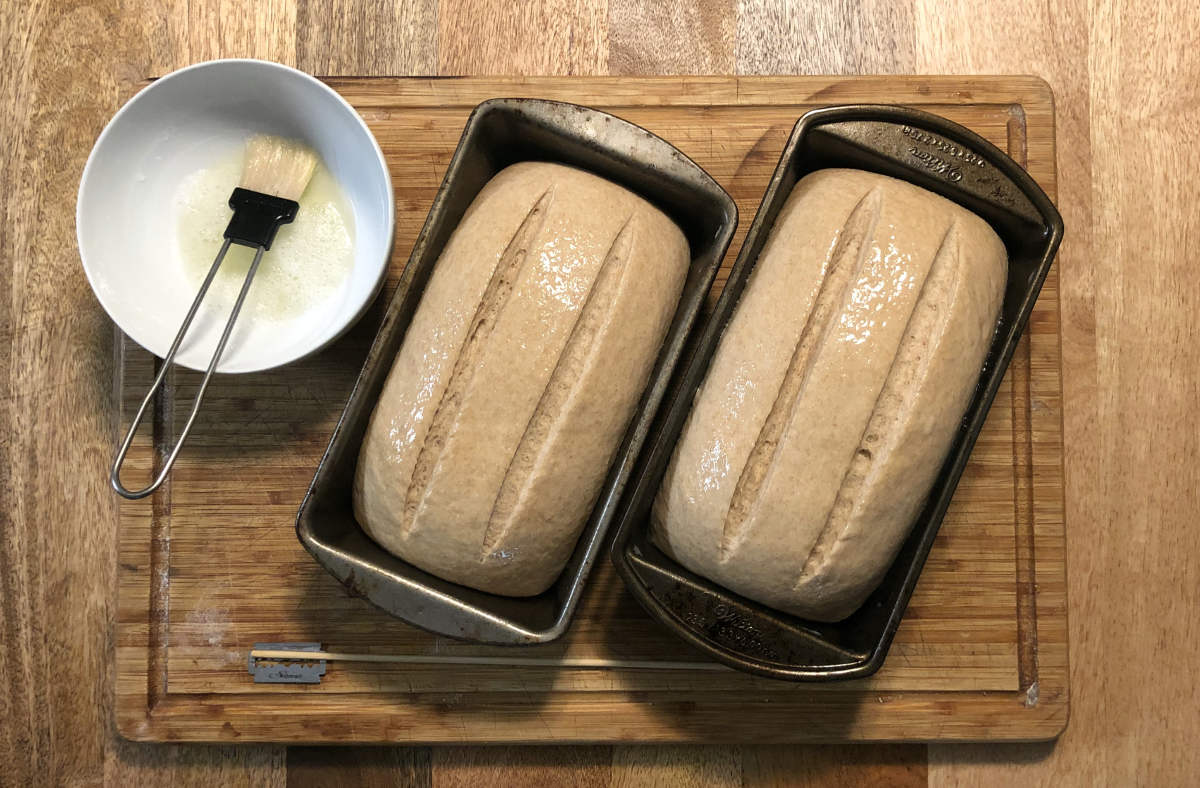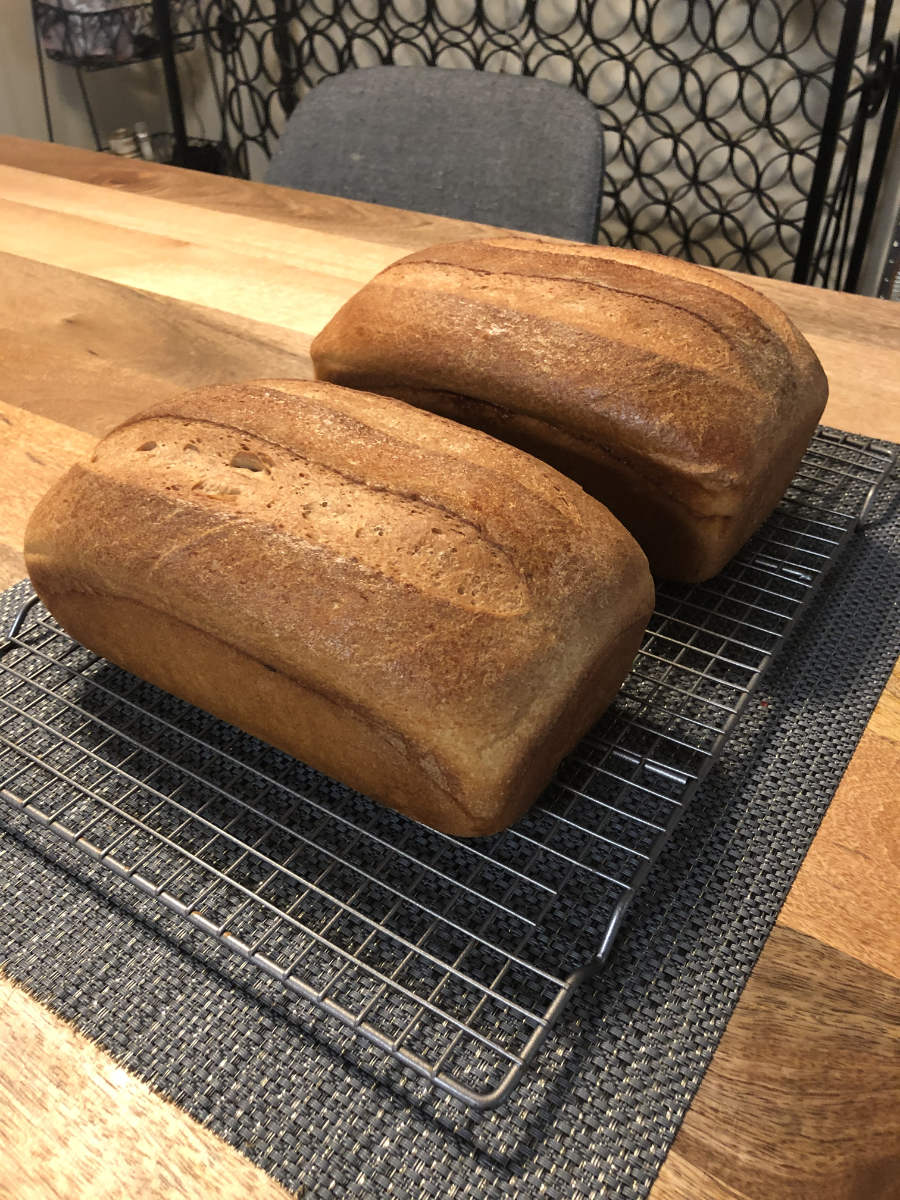Ingredients
Wet Ingredients
- 1 c warm water (110-115 degrees F) 1
- 1 tbsp milk
- 2 tbsp oil
- 2 tbsp honey
- 2 tbsp brown sugar 2
- 1 egg (optional: for egg wash)
Dry Ingredients
- 2 tsp active dry yeast
- 1 tsp salt
- 1 3/4 c (210 gr) all-purpose (AP) flour plus more for kneading 1
- 1 3/4 c (198 gr) whole wheat flour
Hardware
- 2 medium mixing bowls
- whisk
- loaf pan
- spray oil or butter for greasing proofing bowl
- stand mixer and dough hook (optional)
- plastic wrap or tea towel
- probe thermometer
Instructions
- Combine water, milk, and 1/2 brown sugar.
- Add yeast and stir until it dissolves.
- After 2-3 minutes, add in honey, oil, and other half of brown sugar. Oil will not incorporate fully but it needs to be poured over the flour at the same time as the rest of the wet. Do not add it before because it will inhibit gluten formation. I need to look into the behavior of the dough when adding the oil in after the wet ingredients.
- In a separate bowl use dry whisk to combine salt, AP, and whole wheat.
- Combine wet into dry (If doing it by hand, I find that a wooden spoon handle has the best stir-power to stuff-getting-stuck-on-it ratio).
- Rest dough for 10 minutes to allow the flour to hydrate fully.
- Turn dough out onto a floured surface and knead 10-15 minutes. A stand mixer with a dough hook could be used if this does not sound like a good time.
- Clean one of the mixing bowls.
- Grease clean bowl, place dough and cover with plastic wrap or moistened tea towel.
- Let rise until dough has doubled in volume; approximately 40 minutes.
- Punch down dough to remove any large air bubbles then turn out onto the counter and knead for a few minutes. The dough surface should be smooth.
- Flatten dough out into a tall oval then fold the sides in on each other. Then fold the top and bottom together. It should be rectangular(ish) at this point.
- Grease loaf pan and then transfer in dough seam side down.
- Find a means to cover the bread so that nothing will touch its top during its final proof. Chopsticks at the four corners of the bread tin and then tenting the plastic wrap over it would work. So would covering it with a large bowl.
- Let raise for 30 minutes.
- Start pre-heating an oven to 350F when 10 minutes remain.
- (optional) Lightly apply egg wash across the top of the loaf, making sure none of the wash puddles between the pan and the dough. Egg wash is for aesthetic purposes. The bread cooks just fine without it but the crust will finish with a slightly dry appearance.
- With a sharp knife, slice into dough 1/4” deep, the whole length of the bread once or twice. This gives the loaf a place to expand without ripping the top open.
- Place in oven when it has almost doubled in size.
- Bake for 30-35 minutes. If loaf starts browning too soon, lightly lay a piece of foil on top of the loaf to prevent too much darkening.
- Once internal temperature is 195F (regular bread is done at 190F but this has milk, honey, and oil), Remove bread from oven and allow to rest in pan. Remove to a wire rack until fully cool and place in storage.

I usually do double batches of this bread, thus the two loaves.

I stuck with an egg-white wash. It makes for a satin finish. I will eventually test out the differences between differing washes that can be used on bread.

Footnotes
-
Using King Author flour, I use 210 gr AP and 198 gr whole wheat- 208 grams flour total. Water + milk comes in at 251gr. Although this is a approximately a 60% hydration flour, the 2 tbsp honey and 2 tbsp oil has quite an affect on the dough’s handling characteristics. This is something else to play with… ↩ ↩2
-
It’s not really wet, but because it is hydrophilic, it is easier to mix with wet than to be included in the dry ingredients. This is not always the case. I’ll have to chew on this a bit more and come up with a better answer. In the meantime, go look at this question on Quora ↩